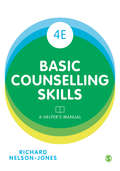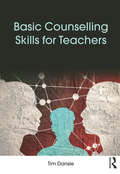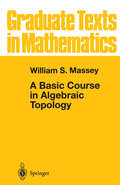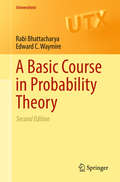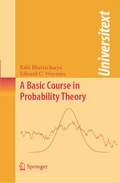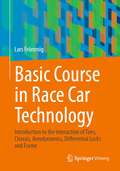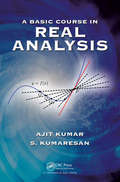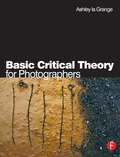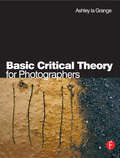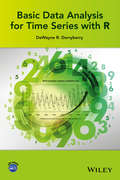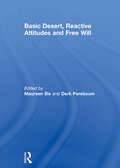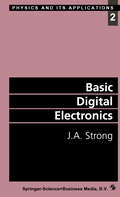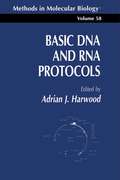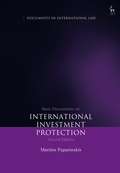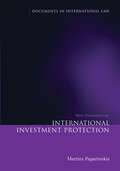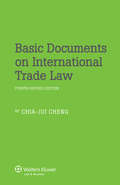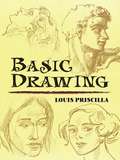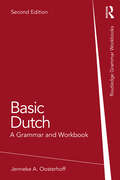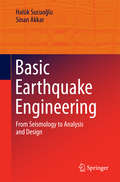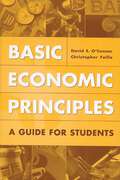- Table View
- List View
Basic Counselling Skills (4th edition) (PDF): A Helper's Manual
by Richard Nelson-JonesThis practical bestseller from leading expert Richard Nelson-Jones introduces the essential counselling skills for the helping professions. Now in its fourth edition, it guides you through the key skills for helping work across a range of settings, such as counselling, nursing, social work, youth work, education and many more. It explores 17 key counselling skills, including: -asking questions -monitoring -facilitating problem solving -negotiating homework Each chapter describes a particular skill, illustrates it using clear case examples across a range of settings and then helps you consolidate and practise what you've learned through a set of creative activities. Further chapters cover professional issues including a new chapter on managing crises and chapters on ethical dilemmas, supervision, working with diversity and more.
Basic Counselling Skills for Teachers
by Tim DansieBasic Counselling Skills for Teachers provides teachers and school staff with an accessible guide, and easy-to-apply skills, to providing counselling to students in a school setting. It looks at what counselling is and what it is not, how to recognise that a student may need counselling, creating the right environment, and maintaining confidentiality. Throughout the book, Tim Dansie provides case studies and strategies for teachers that will help them to encourage students to open up and talk whilst having a model to follow outlining a Solution-Focused Counselling approach. It includes easy-to-understand chapters on counselling for: grief bullying anger anxiety depression friendships career guidance technology addiction. Concise and practical, this book is essential reading for teachers who want to develop their counselling skills and be able to confidently support students in many of the challenges they face on their journey through school.
Basic Counselling Skills for Teachers
by Tim DansieBasic Counselling Skills for Teachers provides teachers and school staff with an accessible guide, and easy-to-apply skills, to providing counselling to students in a school setting. It looks at what counselling is and what it is not, how to recognise that a student may need counselling, creating the right environment, and maintaining confidentiality. Throughout the book, Tim Dansie provides case studies and strategies for teachers that will help them to encourage students to open up and talk whilst having a model to follow outlining a Solution-Focused Counselling approach. It includes easy-to-understand chapters on counselling for: grief bullying anger anxiety depression friendships career guidance technology addiction. Concise and practical, this book is essential reading for teachers who want to develop their counselling skills and be able to confidently support students in many of the challenges they face on their journey through school.
A Basic Course in Algebraic Topology (Graduate Texts in Mathematics #127)
by William S. MasseyThis textbook is intended for a course in algebraic topology at the beginning graduate level. The main topics covered are the classification of compact 2-manifolds, the fundamental group, covering spaces, singular homology theory, and singular cohomology theory. These topics are developed systematically, avoiding all unnecessary definitions, terminology, and technical machinery. The text consists of material from the first five chapters of the author's earlier book, Algebraic Topology; an Introduction (GTM 56) together with almost all of his book, Singular Homology Theory (GTM 70). The material from the two earlier books has been substantially revised, corrected, and brought up to date.
A Basic Course in Probability Theory (Universitext)
by Rabi Bhattacharya Edward C. WaymireThis text develops the necessary background in probability theory underlying diverse treatments of stochastic processes and their wide-ranging applications. In this second edition, the text has been reorganized for didactic purposes, new exercises have been added and basic theory has been expanded. General Markov dependent sequences and their convergence to equilibrium is the subject of an entirely new chapter. The introduction of conditional expectation and conditional probability very early in the text maintains the pedagogic innovation of the first edition; conditional expectation is illustrated in detail in the context of an expanded treatment of martingales, the Markov property, and the strong Markov property. Weak convergence of probabilities on metric spaces and Brownian motion are two topics to highlight. A selection of large deviation and/or concentration inequalities ranging from those of Chebyshev, Cramer–Chernoff, Bahadur–Rao, to Hoeffding have been added, with illustrative comparisons of their use in practice. This also includes a treatment of the Berry–Esseen error estimate in the central limit theorem.The authors assume mathematical maturity at a graduate level; otherwise the book is suitable for students with varying levels of background in analysis and measure theory. For the reader who needs refreshers, theorems from analysis and measure theory used in the main text are provided in comprehensive appendices, along with their proofs, for ease of reference.Rabi Bhattacharya is Professor of Mathematics at the University of Arizona. Edward Waymire is Professor of Mathematics at Oregon State University. Both authors have co-authored numerous books, including a series of four upcoming graduate textbooks in stochastic processes with applications.
A Basic Course in Probability Theory (Universitext)
by Rabi Bhattacharya Edward C. WaymireIntroductory Probability is a pleasure to read and provides a fine answer to the question: How do you construct Brownian motion from scratch, given that you are a competent analyst? There are at least two ways to develop probability theory. The more familiar path is to treat it as its own discipline, and work from intuitive examples such as coin flips and conundrums such as the Monty Hall problem. An alternative is to first develop measure theory and analysis, and then add interpretation. Bhattacharya and Waymire take the second path.
Basic Course in Race Car Technology: Introduction to the Interaction of Tires, Chassis, Aerodynamics, Differential Locks and Frame
by Lars FrömmigThe focus of the book is on the driving dynamics of racing vehicles. The interaction of the tyre, the aerodynamics, of the chassis and the limited slip differential specific to racing vehicles is dealt with. A chapter on the basics of vehicle dynamics makes it possible to get started with this topic even without prior automotive engineering training. A historical review and a consideration of the essential safety aspects create an understanding of higher-level requirements, which are specified, for example, by the technical regulations.
A Basic Course in Real Analysis
by Ajit KumarBased on the authors' combined 35 years of experience in teaching, A Basic Course in Real Analysis introduces students to the aspects of real analysis in a friendly way. The authors offer insights into the way a typical mathematician works observing patterns, conducting experiments by means of looking at or creating examples, trying to understand t
Basic Critical Theory for Photographers
by Ashley la GrangeBasic Critical Theory for Photographers generates discussion, thought and practical assignments around key debates in photography. Ashley la Grange avoids the trap of an elitist and purely academic approach to critical theory, taking a dual theoretical and practical approach when considering the issues. Key critical theory texts (such as Sontag's 'On Photography' and Barthes' 'Camera Lucida') are clarified and shortened. La Grange avoids editorilising, letting the arguments develop as the writers had intended; it is the assignments which call into question each writer's approach and promote debate.This is the ideal book if you want to understand key debates in photography and have a ready-made structure within which to discuss and explore these fascinating issues. It is accessible to students, from high school to university level, but will also be of interest to the general reader and to those photographers whose training and work is concerned with the practical aspects of photography.Also includes invaluable glossary of terms and a substantial index that incorporates the classic texts, helping you to navigate your way through these un-indexed works. The book also contains useful information on photo-mechanical processes, explaining how a photograph can appear very differently, and as a result be interpreted in a range of ways, in a variety of books.
Basic Critical Theory for Photographers
by Ashley la GrangeBasic Critical Theory for Photographers generates discussion, thought and practical assignments around key debates in photography. Ashley la Grange avoids the trap of an elitist and purely academic approach to critical theory, taking a dual theoretical and practical approach when considering the issues. Key critical theory texts (such as Sontag's 'On Photography' and Barthes' 'Camera Lucida') are clarified and shortened. La Grange avoids editorilising, letting the arguments develop as the writers had intended; it is the assignments which call into question each writer's approach and promote debate.This is the ideal book if you want to understand key debates in photography and have a ready-made structure within which to discuss and explore these fascinating issues. It is accessible to students, from high school to university level, but will also be of interest to the general reader and to those photographers whose training and work is concerned with the practical aspects of photography.Also includes invaluable glossary of terms and a substantial index that incorporates the classic texts, helping you to navigate your way through these un-indexed works. The book also contains useful information on photo-mechanical processes, explaining how a photograph can appear very differently, and as a result be interpreted in a range of ways, in a variety of books.
Basic Data Analysis for Time Series with R
by DeWayne R. DerryberryWritten at a readily accessible level, Basic Data Analysis for Time Series with R emphasizes the mathematical importance of collaborative analysis of data used to collect increments of time or space. Balancing a theoretical and practical approach to analyzing data within the context of serial correlation, the book presents a coherent and systematic regression-based approach to model selection. The book illustrates these principles of model selection and model building through the use of information criteria, cross validation, hypothesis tests, and confidence intervals. Focusing on frequency- and time-domain and trigonometric regression as the primary themes, the book also includes modern topical coverage on Fourier series and Akaike's Information Criterion (AIC). In addition, Basic Data Analysis for Time Series with R also features: Real-world examples to provide readers with practical hands-on experience Multiple R software subroutines employed with graphical displays Numerous exercise sets intended to support readers understanding of the core concepts Specific chapters devoted to the analysis of the Wolf sunspot number data and the Vostok ice core data sets
Basic Data Analysis for Time Series with R
by DeWayne R. DerryberryWritten at a readily accessible level, Basic Data Analysis for Time Series with R emphasizes the mathematical importance of collaborative analysis of data used to collect increments of time or space. Balancing a theoretical and practical approach to analyzing data within the context of serial correlation, the book presents a coherent and systematic regression-based approach to model selection. The book illustrates these principles of model selection and model building through the use of information criteria, cross validation, hypothesis tests, and confidence intervals. Focusing on frequency- and time-domain and trigonometric regression as the primary themes, the book also includes modern topical coverage on Fourier series and Akaike's Information Criterion (AIC). In addition, Basic Data Analysis for Time Series with R also features: Real-world examples to provide readers with practical hands-on experience Multiple R software subroutines employed with graphical displays Numerous exercise sets intended to support readers understanding of the core concepts Specific chapters devoted to the analysis of the Wolf sunspot number data and the Vostok ice core data sets
Basic Desert, Reactive Attitudes and Free Will
by Maureen Sie and Derk PereboomBasic Desert, Reactive Attitudes and Free Will addresses the issue of whether we can make sense of the widespread conviction that we are morally responsible beings. It focuses on the claim that we deserve to be blamed and punished for our immoral actions, and how this claim can be justified given the philosophical and scientific reasons to believe that we lack the sort of free will required for this sort of desert. Contributions to the book distinguish between, and explore, two clusters of questions. The first asks what it is to deserve to be harmed or benefitted. What are the bases for desert – actions, good character, bad character, the omission of good character traits? The second cluster explores the disagreement between compatabilists and incompatibilists surrounding the nature of desert. Do we deserve to be harmed, benefitted, or judged, even if we lack the ability to act differently, and if we do not, what effect does this have on our everyday actions? Taken in full, this book sheds light on the notion of desert implicated in our practice of holding each other morally responsible. This book was originally published as a special issue of Philosophical Explorations.
Basic Desert, Reactive Attitudes and Free Will
by Maureen Sie Derk PereboomBasic Desert, Reactive Attitudes and Free Will addresses the issue of whether we can make sense of the widespread conviction that we are morally responsible beings. It focuses on the claim that we deserve to be blamed and punished for our immoral actions, and how this claim can be justified given the philosophical and scientific reasons to believe that we lack the sort of free will required for this sort of desert. Contributions to the book distinguish between, and explore, two clusters of questions. The first asks what it is to deserve to be harmed or benefitted. What are the bases for desert – actions, good character, bad character, the omission of good character traits? The second cluster explores the disagreement between compatabilists and incompatibilists surrounding the nature of desert. Do we deserve to be harmed, benefitted, or judged, even if we lack the ability to act differently, and if we do not, what effect does this have on our everyday actions? Taken in full, this book sheds light on the notion of desert implicated in our practice of holding each other morally responsible. This book was originally published as a special issue of Philosophical Explorations.
Basic Digital Electronics (Physics and Its Applications)
by J. A. StrongModern electronics is the most visible result of research in solid state physics. Transistors and integrated circuits are used everywhere in ever increasing numbers. The microprocessor controlled coffee-pot exists. Most experimental physicists, and, indeed, experimental scientists in most disciplines, study their subject with the aid of apparatus containing significant amounts of electronics and much of that electronics is digital. In order to design experiments and apparatus or simply to understand how a piece of equipment works, an under standing of electronics has become increasingly important. In recognition that electronics has pervaded so many areas, courses in digital electronics are now a recommended part of physics and many other science degree courses. At the introductory level, digital electronics is, primarily, a practical subject with relatively few basic concepts and any complex ity arises from the coupling together of many simple circuits and the extensive use of feedback. Designing an electronic circuit and then getting it to work correctly provides an experience, and a sense of achievement, which is significantly different from most undergradu ate work as it more closely resembles project work than standard laboratory practicals.
Basic Documents on International Investment Protection (Documents in International Law)
by Martins PaparinskisInternational law of foreign investment is a field of public international law that has attracted considerable attention from practitioners, academics, and policy-makers in the last two decades. Its key characteristic is the extent of substantive and procedural decentralisation: while often sharing certain structural elements, both substantive obligations and mechanisms of international dispute settlement are mostly opposable only between the particular parties, even when expressed in multilateral form. This makes a clear and comprehensive overview of the topic particularly important. The second edition adopts a new structure that better reflects the concurrence of various reform proposals with the fairly stable stratum of instruments that inform the current practice. With this systemic dynamic in mind, the selected documents are divided into three parts: Past, Present, and Future. The Past sets out the legal background to modern investment protection law. The Present provides generalist international law materials (sources and responsibility), a selection of the more important instruments with substantive investment rules, and rules of international dispute settlement regarding investment protection. The Future (new for the second edition) lists a number of possible directions of future development, including a variety of approaches that maintain the traditional procedural kernel of investor-State arbitration as well as proposals for more significant change, with non-State actor involvement in dispute settlement either rejected or moulded into a judicial mechanism. This highly regarded book is aimed at teachers, students, practitioners, and policymakers in the area. It can be used both as a practitioners' handbook and as a classroom companion for courses on international dispute settlement and investment protection law.
Basic Documents on International Investment Protection: (fifth Edition) (Documents in International Law)
by Martins PaparinskisInternational law of foreign investment is a field of public international law that has attracted considerable attention from practitioners, academics, and policy-makers in the last two decades. Its key characteristic is the extent of substantive and procedural decentralisation: while often sharing certain structural elements, both substantive obligations and mechanisms of international dispute settlement are mostly opposable only between the particular parties, even when expressed in multilateral form. This makes a clear and comprehensive overview of the topic particularly important. The second edition adopts a new structure that better reflects the concurrence of various reform proposals with the fairly stable stratum of instruments that inform the current practice. With this systemic dynamic in mind, the selected documents are divided into three parts: Past, Present, and Future. The Past sets out the legal background to modern investment protection law. The Present provides generalist international law materials (sources and responsibility), a selection of the more important instruments with substantive investment rules, and rules of international dispute settlement regarding investment protection. The Future (new for the second edition) lists a number of possible directions of future development, including a variety of approaches that maintain the traditional procedural kernel of investor-State arbitration as well as proposals for more significant change, with non-State actor involvement in dispute settlement either rejected or moulded into a judicial mechanism. This highly regarded book is aimed at teachers, students, practitioners, and policymakers in the area. It can be used both as a practitioners' handbook and as a classroom companion for courses on international dispute settlement and investment protection law.
Basic Documents on International Investment Protection (Documents in International Law)
by Martins PaparinskisThe increase in the number and complexity of investor-State treaty arbitrations in the last decade has attracted considerable attention from practitioners and academics of international investment protection law. Rules aimed at regulating the protection of foreign investment have been expressed in a decentralised manner, making a clear and comprehensive overview of the topic important. This volume focuses on the relevant documents and aims to provide an exhaustive treatment of relevant procedural and substantive issues. It includes documents explaining the historical development of investment law, substantive investment rules (multilateral and bilateral treaties and model documents, and general rules on the law of treaties and responsibility) and procedural investment rules (relating to the arbitral process in different fora, immunity, recognition and enforcement). The book is aimed at teachers, students and practitioners in the area. It can be used both as a practitioners' handbook and as a classroom companion for courses on international dispute settlement and investment protection law.
Basic Documents on International Trade Law
by Chia-Jui ChengAnyone involved in trade law knows the time-consuming nature of obtaining primary source material and consulting each of the main trade laws. Now in its fourth edition, Basic Documents in International Trade Law solves this problem by assembling, in a single, easy-to-use resource, a very comprehensive collection of the most important and frequently used documents on the law of international trade. In addition to its obvious practical value, this work reveals much about the process of harmonization in international trade law and the operation of the key international trade bodies. This makes the book a helpful reference for international business lawyers, researchers, legislators and government officials in the field. Since the successful publication of the previous editions of the book, the appearance of new conventions and model laws has considerably enriched the law of international trade, and the present edition contains a wealth of new material. The book has been substantially revised and several new instruments have been included. Among the most significantly important improvements to this new edition are new chapters added to different parts of the book, a redesigned and thoroughly revised Part 6 reflecting the expansion of intellectual property rights under the framework of treaties administered by World International Property Organization, and bibliographies and other research resources updated and enlarged to include an extraordinarily rich collection of books and articles in many trading languages besides English, including, for the first time, major Chinese works in the international trade law field. As the late Prof. Clive M. Schmitthoff commented on the first edition, the book ‘is not only of practical usefulness but has also considerable jurisprudential value’, and ‘reveals the methodology of the harmonization process in the area of international trade law’. The International Business Lawyer first commented in 1987 that the book ‘can only be described as a “vade mecum” for every international business lawyer’, an assessment that now seems more merited than ever.
Basic Drawing
by Louis PriscillaUnique in its presentation, Basic Drawing teaches by example. Through a profusion of self-explanatory drawings, simple rules of procedure are expertly illustrated for artists, enabling them to build a solid foundation in all aspects of art composition.Presenting informative facts rather than ideology, the author begins with perspective and progresses to the figure in movement; light and shade; and detailed anatomy such as the head, neck, facial features, back, hips, legs, feet, arms, and hands. Using hundreds of masterful illustrations from his own portfolio, Priscilla continues with drapery, composition, and trees and landscape, including outdoor sketching. A truly all-in-one manual that belongs on every artist's bookshelf, Basic Drawing outlines the fundamental skills of drawing with an effective and powerful simplicity.
Basic Dutch: A Grammar and Workbook (Routledge Grammar Workbooks)
by Jenneke A. OosterhoffBasic Dutch: A Grammar and Workbook comprises an accessible reference grammar and related exercises in a single volume. This second edition contains new chapters on spelling, pronunciation, and indirect speech, as well as revised and additional exercises with lists of new vocabulary.This comprehensive book presents 31 individual grammar points in realistic contexts, taking a grammatical approach that allows students not already familiar with these structures to become accustomed to their use. Grammar points are followed by examples and exercises, allowing students to reinforce and consolidate their learning. Key features include: a full answer key grammar tables for easy reference frequent comparative references to English grammar appendices of pronunciation, pronouns, and strong verbs a list of new vocabulary at the end of each chapter Suitable for class use or self-study, Basic Dutch is the ideal companion for students in their first year of study, providing the basic tools needed to communicate in a variety of situations and an introduction to Dutch culture.
Basic Dutch: A Grammar and Workbook (Routledge Grammar Workbooks)
by Jenneke A. OosterhoffBasic Dutch: A Grammar and Workbook comprises an accessible reference grammar and related exercises in a single volume. This second edition contains new chapters on spelling, pronunciation, and indirect speech, as well as revised and additional exercises with lists of new vocabulary.This comprehensive book presents 31 individual grammar points in realistic contexts, taking a grammatical approach that allows students not already familiar with these structures to become accustomed to their use. Grammar points are followed by examples and exercises, allowing students to reinforce and consolidate their learning. Key features include: a full answer key grammar tables for easy reference frequent comparative references to English grammar appendices of pronunciation, pronouns, and strong verbs a list of new vocabulary at the end of each chapter Suitable for class use or self-study, Basic Dutch is the ideal companion for students in their first year of study, providing the basic tools needed to communicate in a variety of situations and an introduction to Dutch culture.
Basic Earthquake Engineering: From Seismology to Analysis and Design
by Halûk Sucuoğlu Sinan AkkarThis book provides senior undergraduate students, master students and structural engineers who do not have a background in the field with core knowledge of structural earthquake engineering that will be invaluable in their professional lives. The basics of seismotectonics, including the causes, magnitude, and intensity of earthquakes, are first explained. Then the book introduces basic elements of seismic hazard analysis and presents the concept of a seismic hazard map for use in seismic design. Subsequent chapters cover key aspects of the response analysis of simple systems and building structures to earthquake ground motions, design spectrum, the adoption of seismic analysis procedures in seismic design codes, seismic design principles and seismic design of reinforced concrete structures. Helpful worked examples on seismic analysis of linear, nonlinear and base isolated buildings, earthquake-resistant design of frame and frame-shear wall systems are included, most of which can be solved using a hand calculator.
Basic Economic Principles: A Guide for Students
by David E. O'Connor Christophe FailleThis user-friendly guide explains economic concepts and principles in a lively, informative way. Clear and easy-to-understand definitions and explanations, with examples that relate to issues and problems relevant to teenagers, will help students gain a better understanding of economics. In 15 chapters, the guide covers all the basic information students need to understand the basic concepts and principles of economics, including: definition of economics in historical context; how various economics systems work; how prices are set in the U.S. economy; consumer behavior; factors of production; types of businesses; competition in the marketplace; the functions of money; banking and credit; types of investments; the federal budget and taxation; federal monetary and fiscal policies; income distribution in the United States; labor and management issues; international trade.Each chapter explores a key question in economics, is illustrated with graphs and tables, and features the latest economic data. Profiles of the major economic thinkers who influenced thinking on concepts and principles provide historical context. In addition to improving students' conceptual understanding, the guide also encourages critical thinking by investigating controversial issues related to topics as varied as the minimum wage, the decay of our natural environment, poverty, and business ethics of multinational corporations. An extensive glossary of key economic concepts, terms, and institutions is a handy tool. Unlike cut-and-dried, difficult to follow reference works on economics, this guide, designed and written especially for students, will help readers better understand economic information and issues.
